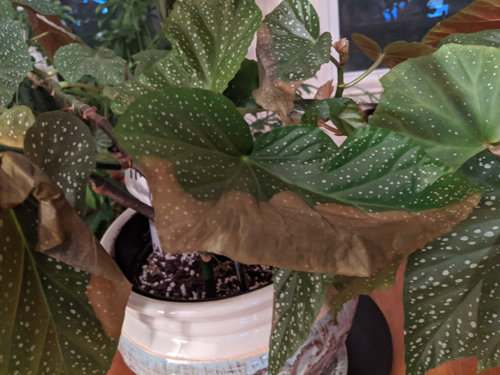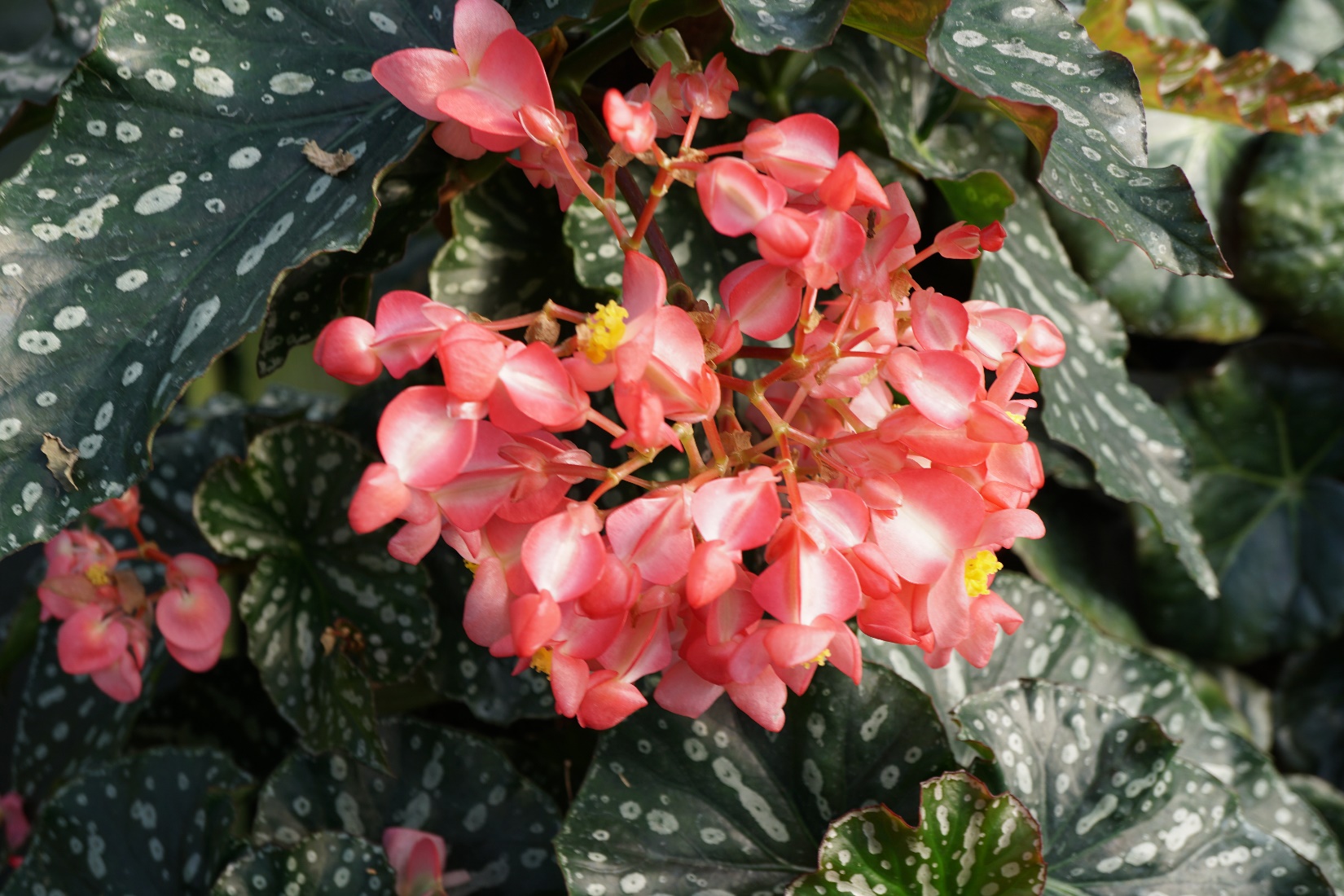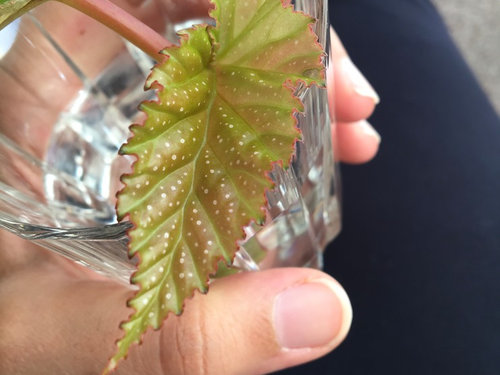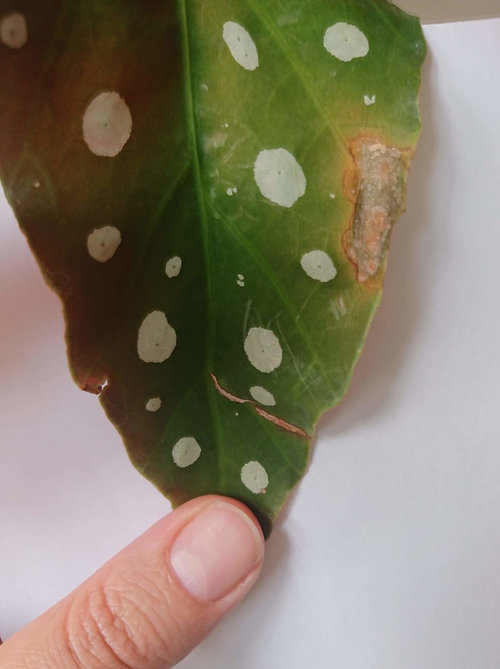Angel Wing Begonia Diseases
Is the Angel Wing Begonia Plant Poisonous. You need to be careful about keeping these plants in or around your home if there are pets or small children present.

Angel Wing Begonia Leaf Edges Browning And Wilting
Angel wing begonia houseplants are susceptible to aphids and spider mites.

Angel wing begonia diseases. If left untreated these soggy brown areas will spread and eventually kill the begonia. This fungal disease attacks this plant when the leaves are kept moist and damp all time. People identify the name angel wing begonia with a beautiful plant that embraces large green leaves and heart shaped blossoms and flowers.
You can spot spider mites by looking for web-like thread hanging from stems and leaves. Angel wing begonias grow between 12 to 20 30 50 cm tall and up to 24 60 cm wide. This is a fungal condition which affects them.
Originally from California the angel wing begonia cultivar is what you get when you cross Begonia aconitifolia and Begonia coccinea. Growing to the maximum heights of ten feet they are easy to grow plant and propagate. Bacterial Leaf Spot and.
Ideally if you live in zones 10 or 11 you wont have a problem with this unique begonia. Botrytis is a sign that you need to prune the interior of your plant to improve air circulation and stop overhead watering. Angel Wing Begonia Common Plant Pests and Diseases The angel wing begonia is susceptible to common houseplant pests including whiteflies aphids spider mites and mealybugs.
Puncture a small hole in the center of the plastic cover. 8 rows Disease Symptoms PathogenCause Management. These plants are considered to be very toxic and can produce a severe allergic reaction upon contact with the skin or when ingested.
Are Angel Wing Begonias Toxic to Pets. Id recommend you hang onto any cuttings as begonias readily propagate. Probably the most obvious difference between these two plants is their height.
Powdery mildew a fungal disease easily recognized by a powdery gray or white covering on the foliage stems and flowers is one of the most common problems to befall angel wing begonias. The angel wing begonia is a type of cane begonia with ornamental wing-shaped leaves that have dotted or speckled patterns. Yes the ASPCA website lists begonia as a plant that is toxic to pets.
This is also the reason why many people choose to grow Angel wing begonias as their houseplants. Angel Wing will otherwise sprawl out and you risk your treasure snapping. Pests and Diseases Affecting Angel Wing Begonia Growth.
Common Pests and Diseases. One of the most typical issues is powdery mildew though they may also contend with rot mealybugs and whiteflies. Insert the angel wing begonia stem through the hole so that the stem is in the water and the leaves are above the cover.
The Begonia Biller Fungal Disease Stem and root rot in begonias is the main culprit here. This variety of Begonia genus is susceptible to powdery mildew. If you see an insect infestation isolate the begonia and treat it with insecticidal soap or an organic insecticide such as neem oil.
You should maintain good airflow around this plant to keep it safe from fungal diseases. If you have curious pets in your home the angel wing begonia may not be. It is spread through moisture such as damp soil and cold weather.
The Angel Wing Begonia responds really well to pruning and will likely flourish if kept slightly smaller and more rounded. Botrytis is a fungal disease that causes splotches of the angel winged begonia to become soggy and brown. Check the water every other day.
Like many houseplants angel wing begonia can come down with a few common afflictions that quickly become a nuisance. The cultivar is best suited for the warm growing zones above 10. Place the cup in a sunny window but avoid windows that get direct hot sunlight.
Viruses often force leaves to develop chlorotic or yellow mottling or mosaic patterns. The Angel Wing Begonia can easily grow up to four feet or more if left unpruned however it is not generally recommended to let them grow to this height without regularly cutting off old stems and trimming down newer ones. The soluble calcium oxalates that the plant contains can cause vomiting and excessive salivation.
This rapidly growing begonia has beautiful clusters of small pink red and orange flowers dangling from red stems. A full-grown Begonia maculata can top out at an impressive five feet tall 150cm though obviously a houseplant can reign in with judicious pruning. The signs of an aphid infestation are small flies crawling underneath foliage or flying around your plants.
Various viruses including tomato spotted wilt impatiens necrotic spot and others can affect begonias. How to Care for an Angel Wing Begonia.

My Angel Wing Begonia Has Browning Crispy Edges Is It Humidity Problems Plantclinic

Begonia Angel Wing Has Scraggly Leaves Gardening Landscaping Stack Exchange

Why Is My Angel Wing Begonia Drooping

Begonias With Leaf Spot Information On Begonia Bacterial Leaf Spot Treatment

Begonia Angel Wing Has Scraggly Leaves Gardening Landscaping Stack Exchange

Begonia Benigo Care Here S What You Need To Know

Why Are My Begonia S Leaves Brown Bloomscape

Begonia Angel Wing Has Scraggly Leaves Gardening Landscaping Stack Exchange

Begonia Maculata Wightii Vs Angel Wing Differences And Similarities Garden For Indoor
8 Tips For Controlling Xanthomonas On Begonia Greenhouse Management

What Causes Brown Spots On Begonia Leaves And Solutions Garden For Indoor

Angel Wing Begonia Leaf Edges Browning And Wilting

Begonia Home Garden Information Center

7 Causes Of Begonia Leaves Turning Brown And Solutions Smart Garden Guide

Thinning Spots On Begonia Leaf

Angel Wing Begonia Leaf Edges Browning And Wilting

Comments
Post a Comment